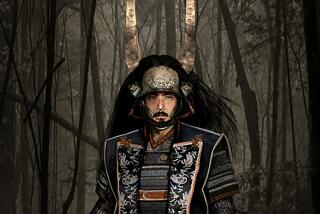Intricate Clothes Make the Miao : Exhibit: Show at the Mingei museum sheds light on our own idiosyncratic rituals by presenting the practices of another culture.
- Share via
SAN DIEGO — If ever the Mingei International Museum of World Folk Art seemed cannily--and not just conveniently--located in a shopping center, it does now. While shoppers bustle through the department stores and franchises of University Towne Centre, seeking the perfectly individualized gift and garment among racks of machine-made, anonymous products, the Mingei offers a visually stunning show about the cultural significance of personal adornment. The show, like so many at the Mingei, sheds light on our own idiosyncratic yet familiar rituals by presenting the parallel practices of another culture.
“From the Land of the Silk Dragon” features exquisite textiles and silver adornments from the Guizhou Province in southern China. The mountainous villages of the province are home to 15 ethnic groups, eight of which are represented in this show.
The exhibition focuses on the Miao people, many of whom migrated from China through Southeast Asia over the past several hundred years to settle in the United States, Canada and other countries under the ancient name of Hmong. San Diego’s large Hmong community descends from the Miao people, and examples of their embroidered textiles are included here, giving the show yet another layer of relevance.
To the Miao, clothes are bearers of both personal and cultural identity. They not only help identify the wearer’s ethnic affiliation, they also reflect his or her personal skills, marital status and wealth. Though all of these indicators are culturally encoded in the patterns and quality of the works on view, guest curator Phila McDaniel has deciphered many of their meanings for the viewer with the help of text panels by several authors and an ample number of color photographs, showing the garments as they appear when worn, especially for festive occasions.
The people of the Guizhou Province value multiple layers of clothing and a rich, profuse style of decoration. Though intricate stitching characterizes most of the work on view, the range of patterns and designs is extremely broad. Boldly colored birds and dragons may cavort across one coat while sedate rows of geometric patterns border the cuffs of another.
The colors, like the designs themselves, bear meaning. The yellow stripes on a cloth baby carrier symbolize the Yellow River, where the Miao people originated. Red stripes on the same piece recall the Yangtze River, where the Miao settled among the river’s tributaries. Forms enclosed by rectangular borders indicate farms and villages in this decorative, symbolic system. Place is distilled into pattern, and the Miao wear their history and their hopes on their backs.
Symbols of prosperity, fertility and protection recur on aprons, skirts and hats, especially the playfully shaped and embroidered “Tiger Hats” made for children. Other garments bear functions integral to the rites of passage of Miao men and women. Ornately stitched yokes or back plates are used in an important courtship ritual: A girl gives her yoke, or “Bai Pai,” to the boy she desires and he shoots an arrow into it. After she does the same with his, the couple is considered engaged.
Embroidery is taught to girls in the province at a young age, and throughout their lives it defines them and their abilities. They create the garments they will wear for festivals and in which they will be courted. They embroider the baby carriers, whose quality indicates their competence as mothers. And as grandmothers, they create garments for their daughters’ children, tightening the bonds between generations and reaffirming cultural tradition.
From spectacular, hand-pleated skirts to marvelous silver necklaces and crowns, the handcrafted works in this show testify to a way of life in which form, function and decoration are seamlessly fused. Just how separate those strands have become in our own culture’s dress codes becomes obvious in contrast to the ways of the Guizhou Province, where a person’s style of dress reflects not only wealth and taste, but skill, a sense of history and community.
* Mingei International Museum of World Folk Art, 4405 La Jolla Village Drive, University Towne Centre. Through December. Hours are 11 a.m.-5 p.m. Tuesday-Saturday, 2-5 p.m. Sunday.
More to Read
The biggest entertainment stories
Get our big stories about Hollywood, film, television, music, arts, culture and more right in your inbox as soon as they publish.
You may occasionally receive promotional content from the Los Angeles Times.










